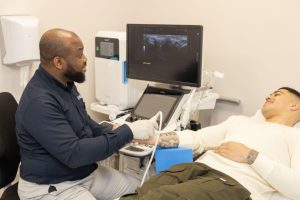Whether you’re a driver or a passenger, many of us spend time in a vehicle during pregnancy without giving it much thought. However, road collisions are the number one cause of mother and unborn baby fatalities in the world. In the US, it’s estimated that each year 3,000 otherwise healthy pregnancies end in miscarriage due to road collisions. In this blog, we’re going to explore all of the ways you can travel safely while pregnant.
Wearing a seatbelt while pregnant
When worn properly, your seatbelt will help to keep you and your baby safe. A study in Northern Ireland showed that 25% of pregnant women didn’t wear a seatbelt at all due to fears of harming their baby. Of those who did wear their seatbelt, 20% of them wore it incorrectly. Seatbelts should always be worn across your chest and across your lap (never wear a lap-only belt). Never place the diagonal part of the belt under your arm or behind your back and never wear the lap part of the belt across or above your bump. The lap belt should be worn under your bump and sit snugly across your hips. Never wear your belt loosely (remove all slack by pulling it tightly) as this would allow it to move during a collision.
Using Airbags while pregnant
The combination of seatbelts and airbags are the most important protection for anyone travelling in a vehicle. Many people are inclined to turn off airbags during pregnancy as they think it’s safer to do so. Airbags are completely safe during pregnancy, however, it’s recommended that you sit as far away as possible from the airbag to lessen the impact. While driving, sit as far away from the steering wheel as possible without impeding your driving. You can also tilt your seat back to increase the area between yourself and the airbag. While you’re a passenger, sit as far back as possible, or even better, sit in the back of the car.
Driving while pregnant
It’s perfectly safe to continue to drive throughout your whole pregnancy as long as you feel well enough to do so. If you’re feeling a lot of discomfort or fatigue then you should stop driving until you feel well again. Driving while sleepy is comparable to driving while drunk, so it’s certainly a case of “better safe than sorry”. As your bump grows, you need to consider how you position your seat. As we mentioned before, your seat should be as far away from the airbags as possible. Your seat should also be pushed back to prevent your bump from touching the steering wheel. You should aim for about 10 inches of space between your steering wheel and your breastbone (the bone that runs along the middle of your chest). If possible, tilt your steering wheel so it’s angled towards your chest rather than your abdomen. If you can’t comfortably reach the pedals, gear stick etc with your seat adjusted to accommodate your bump, then it may be wise to take a break from driving until after your little one is born.
Long Car Journeys
It’s always best to avoid long car journeys while pregnant. However, if it’s unavoidable, make sure to take plenty of breaks to stretch our legs and help blood flow. Pregnant women have a higher risk of developing Deep Vein Thrombosis and therefore should not stay in one sitting position for more than 90 minutes at a time. Make sure to schedule plenty of rest stops along the way. You may also experience dizziness while travelling so pack plenty of healthy energy-rich snacks like fruits and nuts. It may also be best to plan any road trips for your second trimester, this is usually when pregnant women feel their best. Long car journeys during the first trimester may worsen nausea and take more of a toll on the body.
Always be a passenger when possible
Who doesn’t like to be chauffeured? Especially when it’s safer for you and your baby. As your pregnancy progresses it will become more difficult to position yourself in a suitable position in the driver’s seat. Incorrect seat positioning may lead to mistakes such as your foot slipping off the clutch or brake pedal. At the very least, discomfort is always going to pose a distraction while driving, so why take the risk? Also, it’s proven that the back seats of a car are up to 86% safer than the front seats, with the middle seat being the safest seat as you have no risk of hitting your head during a collision, provided you’re wearing your seatbelt correctly. So, whenever possible, choose to relax in the back seat!
Always see a doctor after a collision
Seek medical attention immediately if you have been involved in a collision, regardless of how minor it may have been. Even if you feel fine, you’re at risk of placental abruption and will need an examination. Placental abruption happens when the placenta detaches from the uterus, disrupting the flow of oxygen to the baby. Go to your nearest A&E as soon as possible after an accident to avoid complications.








